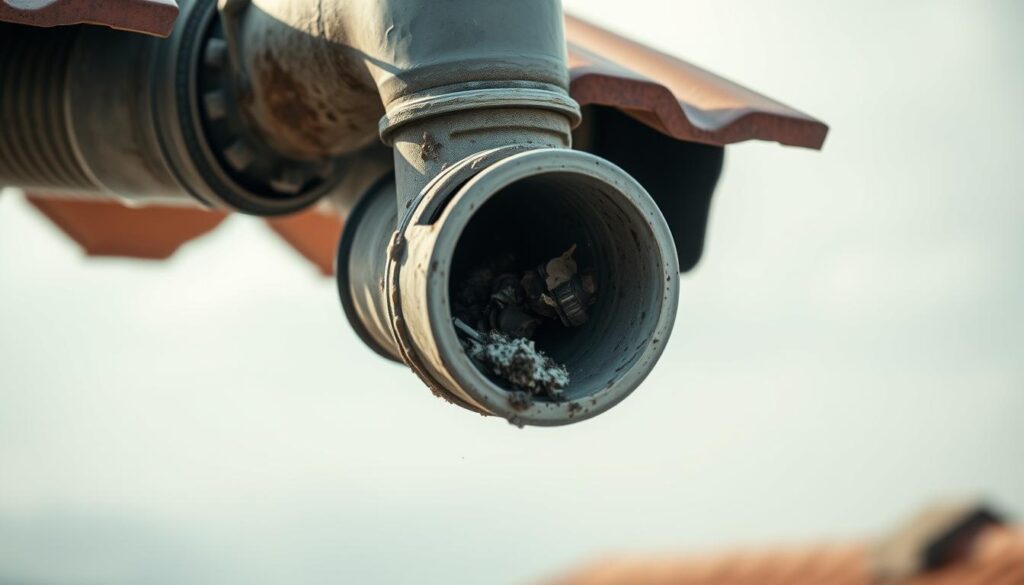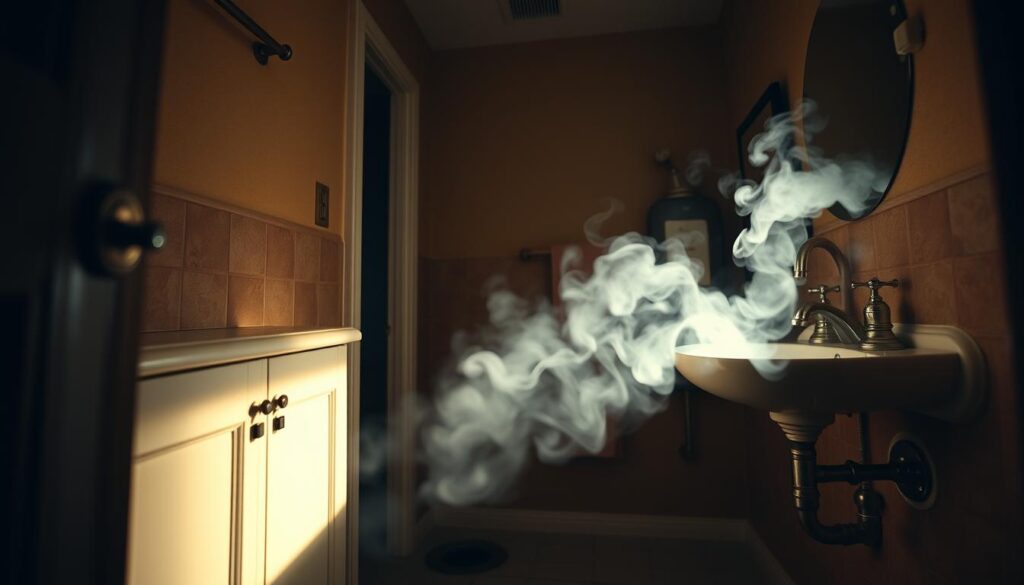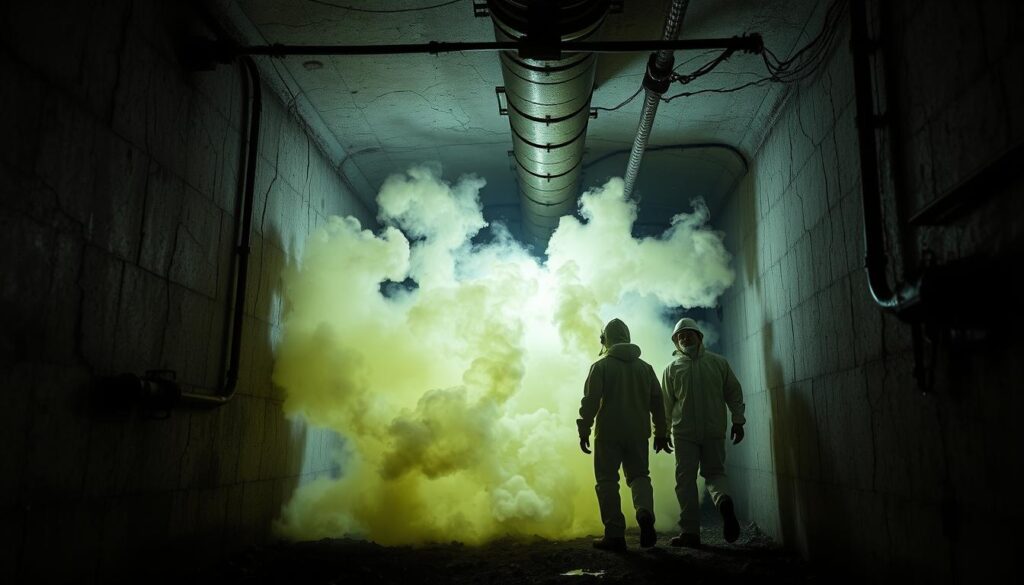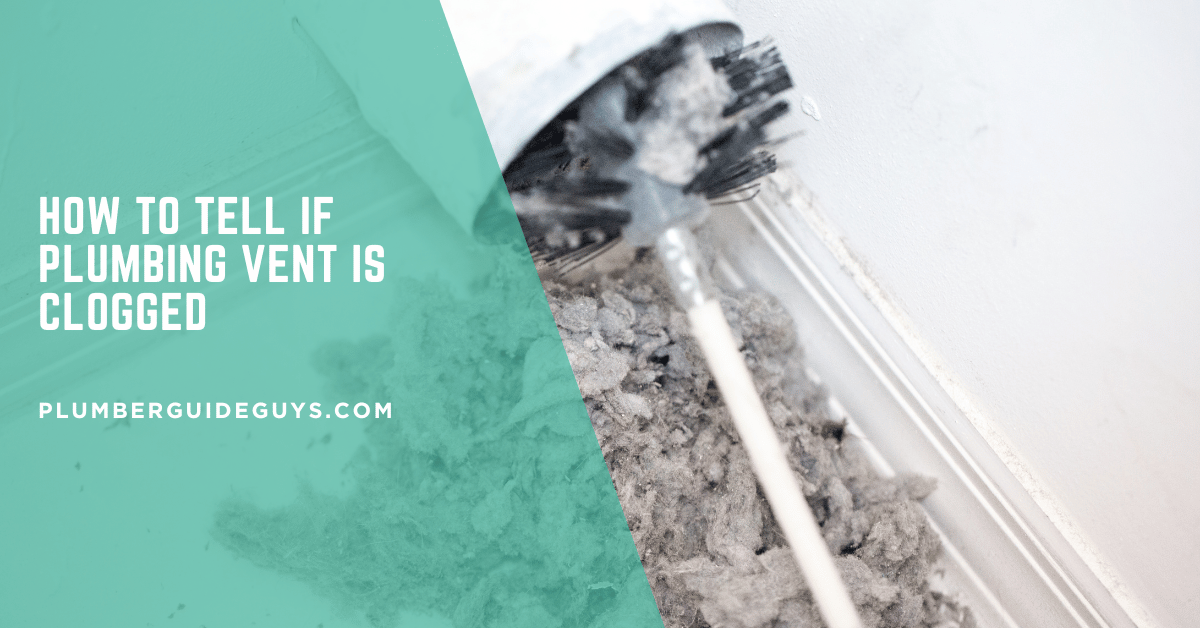Affiliate Disclosure
Plumber Guide Guys is a participant in the Amazon Services LLC Associates Program, an affiliate advertising program designed to provide a means for sites to earn advertising fees by advertising and linking to Amazon.
How to Tell If Plumbing Vent Is Clogged? Did you know a clogged plumbing vent could cost thousands in water damage repairs? Knowing how to spot a clogged vent might save you from big home maintenance problems.

Your home’s plumbing system needs good ventilation to work right. Spotting blockages early can stop serious damage and save you money.
In 2017, water damage claims in the U.S. averaged $10,234. It’s key for homeowners to watch out for plumbing issues. This guide will help you identify and fix clogged plumbing vents.
Key Takeaways
- Learn critical signs of plumbing vent blockages
- Understand the risks of ignoring vent problems
- Know when you need a pro
- Prevent expensive water damage with early detection
- Keep your home’s structure safe
Table of Contents
Understanding the Role of Plumbing Vent Systems
Your home’s plumbing system is more complex than you might think. Plumbing vent systems are key to keeping your drainage system healthy and efficient. They ensure water flows smoothly and prevent blockages in the drain vent pipe.
What is a Plumbing Vent Stack?
A plumbing vent stack is a vertical pipe that goes from your home’s drainage system to the roof. It has several important jobs:
- Releasing sewer gases outside your living space
- Equalizing air pressure within pipe networks
- Preventing clogged vent stack symptoms
- Supporting efficient water drainage
How Air Pressure Regulation Works
Water moving through pipes creates negative pressure. This can slow down drainage. The vent stack brings in fresh air, balancing the pressure. This lets water flow smoothly.
Without enough ventilation, you might face slow drains, gurgling sounds, or blockages.
The Importance of Proper Ventilation
Good plumbing ventilation stops many problems. Inadequate venting can cause big issues like sewage backups, bad smells, and health risks. Keeping your system well-maintained saves you from expensive repairs and keeps your plumbing working well.
Common Causes of Vent Pipe Blockages
Your home’s plumbing vent stack is key to keeping things flowing smoothly. But, it can get clogged by many things. Knowing what can block your vent is the first step to fixing it.
Roof-mounted vent pipes face many dangers. When checking for blockages, look out for these common problems:
- Organic debris like fallen leaves, twigs, and pine needles
- Bird nests and animal intrusions
- Ice and snow in cold areas
- Dust and construction materials
- Dead insects and small animal remains
Seasons change, and so do the challenges for your vent pipe. Winter ice can seal it shut. Summer brings more debris and pests.
Homeowners should check their roof’s vent pipes often. Look for blockages, damaged screens, or animal signs. A quick roof check can stop big plumbing problems.
Regular maintenance is your best defense against unexpected vent pipe blockages.
How to Tell If Plumbing Vent Is Clogged: Key Signs and Symptoms
Spotting vent pipe problems early can prevent expensive repairs and health risks. It’s key to know the signs of a clogged plumbing vent. This helps keep your home’s drainage system working right and avoids bigger issues.
Figuring out if your plumbing vent is clogged means watching for certain signs. These signs can be small or big, each telling you something about your plumbing’s health.
Immediate Warning Signs
- Unusual gurgling sounds coming from drains
- Slow drainage in multiple fixtures
- Water backing up in sinks or toilets
Progressive Symptoms
As a clogged vent gets worse, you’ll see more serious signs that need quick action:
- Persistent foul sewer gas odors in your home
- Recurring toilet flushing problems
- Bubbling or gurgling sounds when water drains
Emergency Indicators
Some signs mean you need to call a plumber right away:
- Complete drainage system failure
- Strong sewage smells throughout your home
- Water backup in multiple plumbing fixtures at once
“Ignoring these signs can lead to significant plumbing damage and health risks.” – Professional Plumbing Association
By watching for these signs, you can catch vent pipe problems early. This way, you avoid big plumbing emergencies.
Slow Draining Water: A Primary Indicator
Slow draining water is a big warning sign. It means your drain vent pipe might be blocked. This blockage makes water flow slowly through your pipes, causing problems with drainage in many places.
It’s important to know the signs of a blocked plumbing vent. This helps keep your home’s drainage system working right. Here are some key signs to look out for:
- Water draining extremely slowly in multiple fixtures
- Simultaneous drainage problems in bathroom and kitchen sinks
- Gurgling sounds after water goes down the drain
- Unexplained standing water in showers or tubs
These signs can show up in different parts of your home. Bathtubs, showers, kitchen sinks, and bathroom drains are often affected when a vent pipe gets blocked.
| Fixture | Potential Drainage Issue | Severity |
|---|---|---|
| Bathtub | Extremely slow water evacuation | High |
| Kitchen Sink | Gurgling and backup | Medium |
| Shower | Water pooling at feet | High |
| Bathroom Sink | Inconsistent drainage speed | Low-Medium |
If you see these problems in many places, it’s time to check for a blockage. Don’t ignore these signs. They could mean a bigger plumbing problem is coming.
Gurgling Sounds in Drains and Pipes
Unusual sounds from your drains can mean more than just a nuisance. Gurgling sounds often point to plumbing problems that need fixing. These sounds are your home’s way of telling you about issues in the plumbing vent system.
Spotting blocked plumbing vent signs early can prevent costly repairs and damage. The gurgling you hear usually comes from air pressure imbalances in your plumbing.
Types of Gurgling Sounds
Different gurgling sounds can show different plumbing problems:
- Soft bubbling: Mild air pressure disruption
- Loud gurgling: Possible significant blockage
- Sustained bubbling: Possible complete vent obstruction
Serious Gurgling Warning Signs
Not all gurgling sounds are the same. Some are more serious and need quick help from a pro:
| Gurgling Intensity | Potential Problem | Recommended Action |
|---|---|---|
| Frequent, loud gurgling | Complete vent blockage | Call plumber immediately |
| Intermittent bubbling | Partial vent obstruction | Inspect and potentially clean vent |
| Persistent drain noise | Potential sewer line issues | Professional diagnostic assessment |
Knowing about gurgling drain symptoms helps you spot blocked plumbing vent issues early. This way, you can avoid big home maintenance problems.
Sewer Gas Odors and Their Connection to Vent Clogs

Finding out why you smell sewer gas is key to a healthy home. A clogged plumbing vent can let dangerous gases into your home. This can make your home smell bad and even be harmful.
Spotting a sewer vent pipe clog means knowing certain smells. Look out for:
- A strong rotten egg smell near drains or toilets
- Persistent sulfur-like odors throughout your home
- Unusual gas emissions from plumbing fixtures
When vent pipes are blocked, gases like hydrogen sulfide and methane can build up. These gases smell bad and can be harmful to your health. They might make you feel sick, dizzy, or nauseous.
- Headaches
- Dizziness
- Nausea
- Respiratory irritation
Your home’s plumbing needs good ventilation to avoid gas buildup. If vent pipes get blocked, air pressure gets out of balance. This lets harmful gases into your home.
Prompt detection and fixing of vent pipe clogs can keep your family safe and avoid plumbing damage.
Experts say to check your vent system often. This keeps it clear and working right. It stops dangerous gas leaks before they start.
Impact on Toilet Performance and Water Levels
A clogged plumbing vent can really mess with your toilet’s performance. It disrupts air pressure, affecting how your toilet works. Spotting a clogged vent means paying attention to small changes in your toilet’s behavior.
Homeowners should watch for signs of a clogged vent stack. These issues often start small but can grow if not caught early.
Changes in Flush Strength
Your toilet’s flush strength depends on good ventilation. A blocked vent can cause:
- Weak, inconsistent flush power
- Incomplete waste removal
- Multiple flushing needed to clear the bowl
Tank Refill Issues
Air pressure is key for tank refilling. A clogged vent can lead to:
- Slow tank water refill
- Unusual water level changes
- Hard time keeping tank water levels steady
These signs point to ventilation problems that need fixing fast. Ignoring them could lead to bigger plumbing issues.
The Role of P-Traps in Vent System Function
P-traps are key parts of your home’s plumbing. They help keep sewer gases out of your living areas. Knowing how they work helps spot problems early.
P-traps keep a water seal that stops bad smells and gases. This seal is like a shield, keeping your home safe. It’s important to have the right venting to keep this balance.
- Blocks toxic sewer gases from entering living spaces
- Creates a critical water barrier in pipe systems
- Helps maintain proper air pressure in plumbing lines
If your vent system fails, P-traps can’t do their job. Blocked vents can break the water seal. This lets bad smells and gases into your home. It’s a health risk and makes living uncomfortable.
Check your P-traps often and watch for signs like strange sounds or bad smells. These signs mean you might have a vent problem that needs fixing fast.
Health Risks Associated with Clogged Vent Pipes

Clogged plumbing vent pipes can pose serious health risks. Many homeowners don’t realize this. It’s important to know the signs of a blocked vent to keep your family safe. Sewer gas smells can vary, from mild to severe, and can be harmful.
Common Health Symptoms of Sewer Gas Exposure
Blocked plumbing vents can let toxic gases into your home. These gases can cause health problems:
- Persistent headaches
- Unexplained nausea
- Sudden dizziness
- Breathing difficulties
- Irritation to eyes and respiratory system
Long-Term Exposure Concerns
Long-term exposure to sewer gases can cause serious health issues. Gases like methane and hydrogen sulfide can harm your lungs and brain.
Immediate action is essential when you detect unusual odors or experience persistent symptoms related to possible sewer gas leaks.
The main risks include neurological damage, breathing infections, and even oxygen loss leading to asphyxiation.
When to Call a Professional Plumber
Figuring out vent pipe problems can be hard. Sometimes, you really need a pro’s help. While some small issues can be fixed on your own, others need a pro. Always put safety first when working with plumbing.
Here are times when you should call a professional plumber:
- Roof access is unsafe or hard to get to
- Many drains in your home keep having problems
- Gurgling sounds keep happening after you try simple fixes
- Sewer gas smells won’t go away, even after trying
Professional plumbers have special tools for checking if your plumbing vent is. They can do detailed tests that go beyond just looking. This ensures they really check your plumbing vent system.
Warning signs that mean it’s time to call a pro:
- Constant sewage backups
- Water keeps backing up in different fixtures
- Water damage shows up near plumbing areas
- Strange bubbling or gurgling sounds in drains
Trying to fix big problems without knowing what you’re doing can cost a lot. A licensed plumber can find and fix vent pipe issues fast. This saves you time, money, and prevents bigger problems later.
Prevention Tips and Regular Maintenance
Keeping your plumbing vent system clear is key to avoiding blockages and ensuring good home drainage. Regular maintenance can save you from expensive repairs and unexpected plumbing problems.
Protecting your plumbing vent system needs a smart plan. Regular checks and preventive steps can greatly lower the chance of blockage signs.
Seasonal Maintenance Strategies
- Inspect roof vent openings during spring and fall
- Clear debris from vent pipe entrances
- Trim nearby tree branches that could obstruct vents
- Check for animal nests or possible blockages
DIY Inspection Guidelines
- Use binoculars to examine roof vent caps from the ground
- Look for visible obstructions or damaged vent covers
- Listen for unusual gurgling sounds in drains
- Check for water backup or slow drainage
To keep your plumbing vent in top shape, think about installing protective vent guards. These simple devices can stop debris, leaves, and small animals from getting into your vent system.
Pro Tip: Annual professional inspection can catch issues before they become big problems.
By following these maintenance tips, you can stay ahead of clog detection challenges and protect your home’s plumbing.
Conclusion
Knowing how to spot a clogged plumbing vent can save you a lot of money and keep you safe. Your home’s plumbing needs good ventilation to work right. Spotting blockages early can stop bigger problems that harm your home and health.
Keeping up with maintenance and staying alert is important for your plumbing. You can fix some small issues yourself, but big blockages need a pro. Watch for signs like slow drains, weird noises, and bad smells that mean your vent might be blocked.
Being proactive is key. Set up regular checks, make sure vent pipes are clear, and call a plumber if you think there’s a big issue. This way, your plumbing stays in good shape, safe, and efficient for a long time.
Remember, a well-kept plumbing vent system is a smart investment in your home’s future. Don’t wait for small problems to turn into big, expensive repairs.
FAQ
What are the most common signs of a clogged plumbing vent?
How dangerous are sewer gases if my plumbing vent is clogged?
Can I diagnose a clogged plumbing vent by myself?
How often should I inspect my plumbing vent system?
What causes plumbing vent blockages?
How much does it cost to fix a clogged plumbing vent?
What are the most common signs of a clogged plumbing vent?
How dangerous are sewer gases if my plumbing vent is clogged?
Can I diagnose a clogged plumbing vent by myself?
How often should I inspect my plumbing vent system?
What causes plumbing vent blockages?
How much does it cost to fix a clogged plumbing vent?
FAQ
What are the most common signs of a clogged plumbing vent?
Signs include slow water draining, gurgling sounds, and sewer gas smells. You might also notice weak toilet flushing or unusual water levels. These signs mean you need to check your plumbing vent system fast.
How dangerous are sewer gases if my plumbing vent is clogged?
Sewer gases are very harmful. They contain toxic gases like hydrogen sulfide and methane. Long-term exposure can cause headaches, nausea, and dizziness. It can even lead to serious breathing problems or asphyxiation.
Can I diagnose a clogged plumbing vent by myself?
Some signs are easy to spot, like gurgling sounds or slow drains. But, a full diagnosis needs a pro. You can start by checking drains and smells. Yet, a plumber can do a deeper check.
How often should I inspect my plumbing vent system?
Check your plumbing vent system twice a year, in spring and fall. Look for debris, animal nests, and roof damage around vent stacks. This keeps your system working right.
What causes plumbing vent blockages?
Blockages come from outdoor debris, bird nests, and ice in cold weather. Small animals and dirt also cause problems. Seasonal changes can affect your vent pipes.
How much does it cost to fix a clogged plumbing vent?
Costs vary based on the blockage’s severity and location. Minor clogs might cost 0-0. But, bigger issues could cost 0 to
FAQ
What are the most common signs of a clogged plumbing vent?
Signs include slow water draining, gurgling sounds, and sewer gas smells. You might also notice weak toilet flushing or unusual water levels. These signs mean you need to check your plumbing vent system fast.
How dangerous are sewer gases if my plumbing vent is clogged?
Sewer gases are very harmful. They contain toxic gases like hydrogen sulfide and methane. Long-term exposure can cause headaches, nausea, and dizziness. It can even lead to serious breathing problems or asphyxiation.
Can I diagnose a clogged plumbing vent by myself?
Some signs are easy to spot, like gurgling sounds or slow drains. But, a full diagnosis needs a pro. You can start by checking drains and smells. Yet, a plumber can do a deeper check.
How often should I inspect my plumbing vent system?
Check your plumbing vent system twice a year, in spring and fall. Look for debris, animal nests, and roof damage around vent stacks. This keeps your system working right.
What causes plumbing vent blockages?
Blockages come from outdoor debris, bird nests, and ice in cold weather. Small animals and dirt also cause problems. Seasonal changes can affect your vent pipes.
How much does it cost to fix a clogged plumbing vent?
Costs vary based on the blockage’s severity and location. Minor clogs might cost $100-$300. But, bigger issues could cost $500 to $1,500. Getting a pro to inspect helps estimate costs.
Can a clogged vent cause long-term plumbing damage?
Yes, ignoring vent clogs can cause serious damage. This includes pipe corrosion, water pressure issues, and sewage backups. Fixing it quickly prevents costly repairs later.
What should I do if I suspect a plumbing vent blockage?
First, write down the symptoms you see. Check drains for similar problems, listen for odd sounds, and smell for gas. Don’t try to fix it yourself. Call a licensed plumber for a proper check and fix.
,500. Getting a pro to inspect helps estimate costs.
Can a clogged vent cause long-term plumbing damage?
Yes, ignoring vent clogs can cause serious damage. This includes pipe corrosion, water pressure issues, and sewage backups. Fixing it quickly prevents costly repairs later.
What should I do if I suspect a plumbing vent blockage?
First, write down the symptoms you see. Check drains for similar problems, listen for odd sounds, and smell for gas. Don’t try to fix it yourself. Call a licensed plumber for a proper check and fix.

